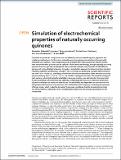Simulation of electrochemical properties of naturally occurring quinones
Abstract
Quinones are produced in organisms and are utilized as electron transfer agents, pigments and in defence mechanisms. Furthermore, naturally occurring quinones can also be cytotoxins with antibacterial properties. These properties can be linked to their redox properties. Recent studies have also shown that quinones can be utilized in flow battery technology, though naturally occurring quinones have not yet been investigated. Here, we have analyzed the properties of 990 different quinones of various biological sources through a computation approach to determine their standard reduction potentials and aqueous solubility. The screening was performed using the PBE functional and the 6-31G** basis set, providing a distribution of reduction potentials of the naturally occurring quinones varying from − 1.4 V to 1.5 V vs. the standard hydrogen electrode. The solvation energy for each quinone, which indicates the solubility in aqueous solution, was calculated at the same level. A large distribution of solubilities was obtained, containing both molecules that show tendencies of good solubilities and molecules that do not. The solubilities are dependent on the nature of the side groups and the size of the molecules. Our study shows that the group containing the quinones of fungal origin, which is also the largest of the groups considered, has the largest antimicrobial and electrochemical potential, when considering the distribution of reduction potentials for the compounds.
Citation
Birkedal Kristensen , S , van Mourik , T , Brunn Pedersen , T , Laurids Sørensen , J & Muff , J 2020 , ' Simulation of electrochemical properties of naturally occurring quinones ' , Scientific Reports , vol. 10 , 13571 . https://doi.org/10.1038/s41598-020-70522-z
Publication
Scientific Reports
Status
Peer reviewed
ISSN
2045-2322Type
Journal article
Description
This study was supported by grants from The Danish Research Council, Technology and Production (grant no. 7017-00167) and the Novo Nordisk Foundation (NNF18OC0034952).Collections
Items in the St Andrews Research Repository are protected by copyright, with all rights reserved, unless otherwise indicated.

